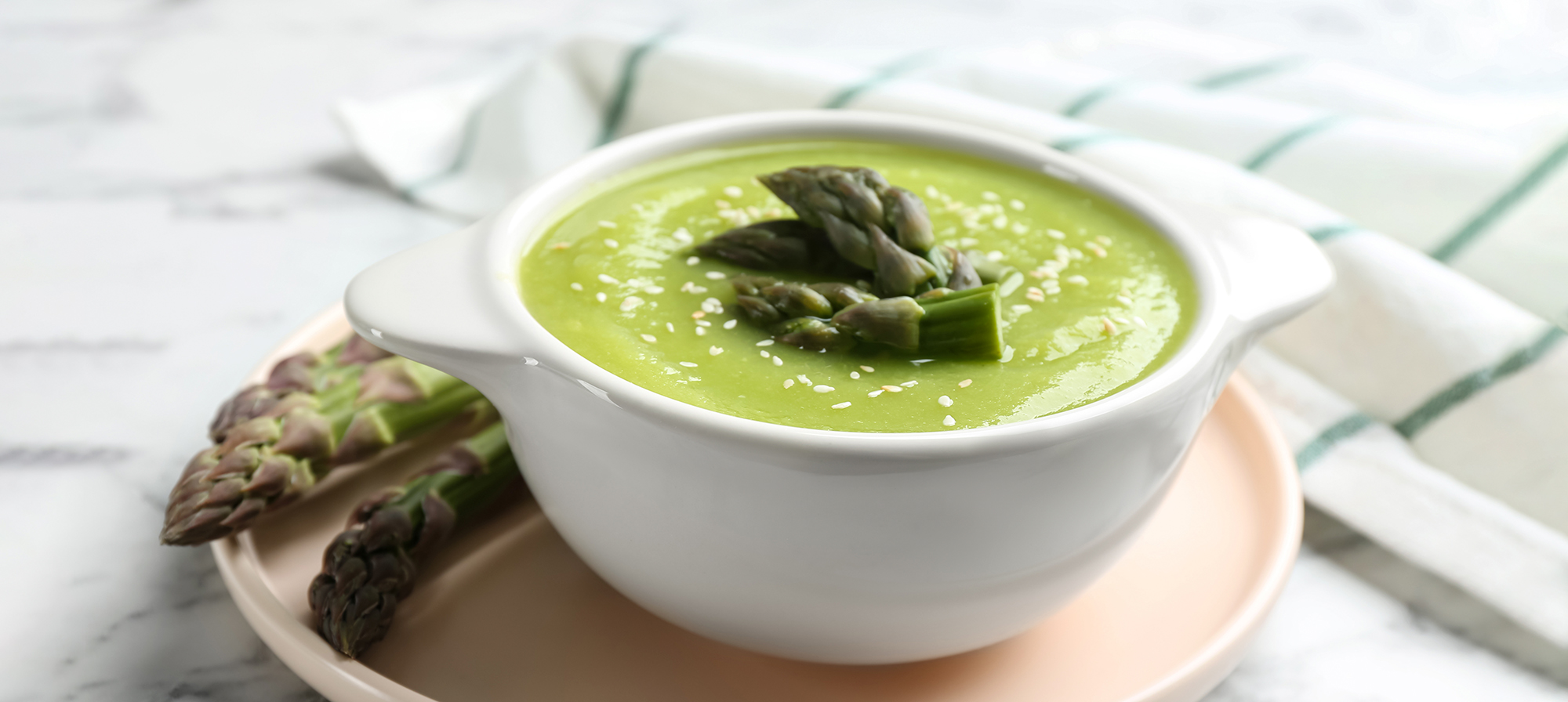Is anything more satisfying than a rich, creamy bowl of soup? Think cream of broccoli, cream of potato, or cream of corn. The only problem with these soups is they often call for a lot of butter, cream, and milk—the very ingredients that give them their rich, smooth taste and all the added fat and calories.
If you’re watching your weight, you might think you’ll have to give up such creamy delights. Not so. There’s an easy culinary hack that will cut down on the fat and calories while keeping the rich, creamy taste. Just puree your soup ingredients in a blender—minus the cream and butter, of course.
One popular veggie often used in such pureed soup recipes is asparagus. It blends up into a surprisingly creamy, yet low-calorie, soup. And it’s brimming with nutrients. Plus, it’s quick and easy to make.
Nutrients in asparagus offer a host of health perks
Asparagus is a classic springtime veggie . In fact, it’s one of the first veggies to show up in the produce section at winter’s end. So, what better time to add it to your plate or soup bowl? Whether grilled, steamed, roasted, or in soups and casseroles, these spears have a lot to offer besides great taste. They have no fat or cholesterol and are low in sodium. Plus, they’re brimming with fiber, protein, and a wide range of other nutrients , such as:
Vitamins
- B9 (folate): helps form blood cells and supports cell growth and function
- A: helps support eye health and protects cells against free radical damage
- K: helps your blood clot and helps build strong bones
- C: helps boost your immune system and is needed to build muscle, cartilage, and blood vessels
Minerals
- Iron: helps support the birth of red blood cells, which carry oxygen to all the tissues of your body
- Potassium: helps muscles and nerves function and regulates heart rate; may also help support healthy blood pressure
- Calcium: helps build strong bones and supports healthy function of your nerves, muscles, and heart
Green is not the only color asparagus comes in. You can also choose purple or white spears, both of which are similar in nutrients. They differ slightly from green in texture and taste. Purple is thought to be a bit sweeter, and white is slightly more tender.

A few asparagus side effects to keep in mind
If you eat asparagus often, you may notice one or more of these:
- Strong-smelling urine: A sulfur-based compound in asparagus can cause some, but not all, people’s urine to smell a little funny. This side effect is not thought to be harmful.
- Gas: Asparagus is very high in fiber and may cause some gas after eating it.
- Drug interactions: Check with your doctor if you take any meds, especially a blood thinner. The vitamin K in asparagus helps blood clot more quickly, so it can work against the action of some blood thinners.
- Allergies: Some people can have an allergic reaction to asparagus. It may cause a rash or itchy, red skin, even just from touching it. For some, inhaling or eating asparagus may cause trouble with breathing. If you know you are allergic to onions, garlic, or chives, you may be allergic to asparagus as well.
Tips for buying, storing, and prepping asparagus
Look for asparagus with firm spears and tips versus wilted or droopy ones. Before cooking it, wash and cut or break off about an inch or two off the bottom of the stem ends. (The ends tend to be fibrous and tough.) Learn more helpful tips for storing and prepping asparagus
Carrots can add a hint of sweetness and even more health perks
Another veggie that’s great to add to asparagus soup: carrots. They add a sweet taste to help offset the slightly bitter taste of asparagus. Carrots are also high in vitamin A. And they’re loaded with fiber, which can curb hunger pangs and support healthy blood pressure.
Now that you have the lowdown on all the health perks of these 2 veggies—why not use your blender and whip up a batch of the yummy asparagus soup recipe below?
Asparagus Vegetable Soup Recipe
Ingredients
- 1 tablespoon vegetable oil
- ½ cup chopped carrots
- 2 garlic cloves, minced
- ½ teaspoon salt
- ¼ teaspoon black pepper
- ½ teaspoon rosemary
- 4 cups vegetable broth
- 5 cups chopped asparagus, uncooked
Directions
Heat oil in a large stockpot over medium heat. Add carrots, garlic, salt, black pepper, and rosemary, and cook for 10 minutes. Reduce heat to low; cover and cook 5 minutes. Add vegetable broth and bring to a boil. Reduce heat and simmer, partially covered, 15 – 20 minutes or until carrots are tender.
Add the chopped asparagus and cook for 5 – 10 minutes until tender. Let the mixture cool for 5 – 10 minutes. Puree the asparagus mixture in a blender. Return pureed mixture to stockpot. Cook over low heat 5 minutes or until thoroughly heated, stirring occasionally.
Yield: 6 servings
Prep Time: 10 minutes
Cook Time: 45 minutes
Difficulty: Easy
| Nutrition Facts |
| Calories 68 |
| Fat calories 25 |
| Total fat 2.8g |
| Saturated fat 0.3g |
| Cholesterol 0mg |
| Sodium 471.5mg |
| Total carbohydrate 9.1g |
| Dietary fiber 3g |
| Sugars 4.7g |
| Protein 3.3g |
Not a Silver&Fit® member? Learn more about everything the program has to offer, including more helpful healthy living tips like this, here on our website.
This information is not intended to take the place of regular medical care or advice. Please check with your doctor before using this information or beginning any self-care program. Images used for this article do not depict any members of the Silver&Fit program.
References
Cleveland Clinic. (2021, March 23). Reasons why carrots of all colors are healthy for you. https://health.clevelandclinic.org/reasons-why-carrots-of-all-colors-are-healthy-for-you/
Harvard T. H. Chan School of Public Health. (2023, March). Iron. https://www.hsph.harvard.edu/nutritionsource/iron/
Harvard T. H. Chan School of Public Health. (2023, March). Vitamin K. https://www.hsph.harvard.edu/nutritionsource/vitamin-k/
Mayo Clinic. (2023, August 10). Folate (folic acid). https://www.mayoclinic.org/drugs-supplements-folate/art-20364625
Mayo Clinic. (2023, September 14). Vitamin A. https://www.mayoclinic.org/drugs-supplements-vitamin-a/art-20365945
Mayo Clinic. (2023, August 10). Vitamin C. https://www.mayoclinic.org/drugs-supplements-vitamin-c/art-20363932
Medline Plus. (2017, October 20). Potassium. https://medlineplus.gov/potassium.html
Mitchell, S. C. (2013). Asparagus, urinary odor, and 1,2-dithiolane-4-carboxylic acid. Perspectives in Biology and Medicine, 56(3), 341-351. doi:10.1353/pbm.2013.0031
Montana State University. (n.d.). Asparagus. https://buyeatlivebetter.org/main_documents/factsheets/msu_extension_food_fact_sheets/AsparagusFFS.pdf
Tabar, A. I., Alvarez-Puebla, M. J., Gomez, B., Sanches-Monge, R., Garcia, B. E., Echechipia, S., Olaguibel, J. M., Salcedo, G. (2014, January). The diversity of asparagus allergy: Clinical and immunological features. Clinical and Experimental Allergy, 34(1),131-136. doi:10.1111/j.1365-2222.2004.01856.x
University of Iowa, Health Care. (2025, April). Warifin, your diet, and vitamin k foods. https://uihc.org/educational-resources/warfarin-your-diet-and-vitamin-k-foods
United States Department of Agriculture. (n.d.). Asparagus: When is asparagus in season? https://snaped.fns.usda.gov/seasonal-produce-guide/asparagus
This article was written by Gail Olson, edited by Jason Nielsen, and clinically reviewed by Elizabeth Thompson, MPH, RDN, on February 3, 2025.






